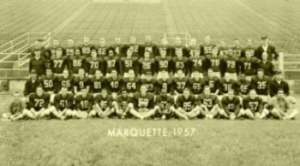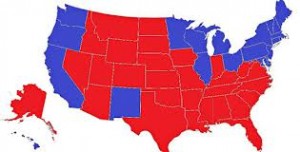More on Marquette Football
 In a comment to my earlier post marking the 52nd anniversary of Marquette’s final varsity football game, Nick Zales asked why Marquette decided to terminate its 78-year-old football program in 1960.
In a comment to my earlier post marking the 52nd anniversary of Marquette’s final varsity football game, Nick Zales asked why Marquette decided to terminate its 78-year-old football program in 1960.
The explanation given at the time was that a competitive football team was too expensive for Marquette to maintain in light of the university’s plans for further expansion. (Plans for a 10-year, $30 million fund-raising campaign to pay for additional campus improvements, higher faculty salaries, and more student financial aid had just been announced.)
In revealing the plan to shut down the football and track-and-field programs at the end of the 1960-61 academic year, President O’Donnell stated that the University Athletic Board had, at his request, voted to terminate the two sports because of the university’s “reasonable unwillingness to accept the financial hardships imposed by these two sports in light of the other needs of the university.” The football team had reportedly lost $50,000 over the course of the fall 1960 season and had run at a deficit for several years.
From the perspective of more than a half century, it is hard to evaluate the wisdom of O’Donnell’s decision. The decision to end football was certainly unpopular with students, alumni, and Marquette fans at the time. Shortly after the announcement, an estimated 3000 students marched from the campus through downtown Milwaukee chanting, “We want football. We want justice.”
At the same time, an alumni group, led by Milwaukee businessman Johnny Sisk, pledged to raise the money necessary to pay off the athletic department’s deficit and collected $15,000 the first week. (Sisk had starred for Marquette in the 1930’s before moving on to a five-year career as a halfback for the Chicago Bears. He also had a son on the current Marquette team.)
Although the effort to reverse President O’Donnell’s decision received coverage in the New York Times and other national media outlets, the efforts were to no avail, and football did not return to Marquette.
But was it really necessary to terminate the Marquette football program in 1960?
While it was true that the Marquette football team had done poorly in the mid to late 1950’s—a combined won-lost record of 13-50-3 from 1954 to 1960—the program’s prospects were clearly looking up after the 1960 season. Although the 1960 team had finished with a mediocre 3-6-0 record, the season had started on a strong note at 3-1-0 before Marquette’s fortunes were derailed by injuries. Attendance at Marquette games was up in 1960, and the team had secured permission to play home games in Milwaukee County Stadium, the home of the Braves and Packers (when they played in Milwaukee).
Furthermore, there was every reason to think that the Marquette football team would be much better (and draw in greater revenues) in 1961. In spite of its so-so record, the 1960 team was actually laden with talent; only two starters (both interior linemen) from 1960 were graduating; and the team’s two top stars, halfback David Thiesen and end George Andrie, were among those returning.
Even though Marquette dropped football after the 1960 season, four members of the 1960 team—Andrie, end Pete Hall, and halfbacks Karl Kassulke and John Sisk, Jr.—went on to play in the NFL. Moreover, the fact that fullback Frank Mestnik had moved from the 1959 Marquette team to a starting position with the NFL’s St. Louis Cardinals in 1960 was proof that Marquette could still recruit from the ranks of the top college players.
Furthermore, 1960 was an unusual time for a college, especially the largest Catholic university in the United States, to drop football. From the onset of the Great Depression through the early 1950’s, a significant number of American colleges and universities discontinued their “big-time” football programs because of financial concerns. Most of the colleges that did so were Roman Catholic schools.
Twenty Catholic colleges dropped “big time” football between 1930 and 1954. Including Loyola of Chicago (1930); Loyola of Baltimore (1933); St. Francis of New York (1935); DePaul (c.1938); St. Joseph’s (1939); Gonzaga and Providence (1941); Creighton and Manhattan (1942); St. Francis of Pennsylvania (1946); St. Louis and Portland (1949); Duquesne, Georgetown, Mt. Saint Mary’s, and Niagara (1950); Loyola of Los Angeles and St. Bonaventure (1951); San Francisco (1952); and Fordham (1954).
Several of these schools, especially Fordham and San Francisco, had once been ranked among the top football programs in the United States. (The year in parentheses is the last year the school competed in football, and not necessarily the year in which the decision to eliminate the program was made.)
(Until 1956, the NCAA did not classify its members into divisions, so the category of schools playing “big-time” football was somewhat subjective. After 1956, the NCAA was divided into University and College divisions, which then defined the line between “big-time” and “small college” football. The use of three classifications—Divisions I, II, and III—began in 1973.)
However, relatively few colleges dropped big-time football after 1954. In fact, between 1954 and 1972, only two Catholic colleges gave up football—Marquette and the University of Detroit (1964). Marquette and Detroit (now Detroit Mercy) had played each other for decades, and it is likely that had Marquette not dropped football, Detroit would not have either. (The University of Scranton also dropped football in 1960, but at that time, Scranton played in the “small college” division of the NCAA.)
While 20 Catholic schools did drop football before 1954, there were many others that continued to play football in the NCAA’s highest division after Marquette dropped the sport in 1960. That list obviously includes Notre Dame and Boston College, but it also contains Canisius, Fairfield, Holy Cross, Iona, LaSalle, St. John’s (NY), St. Mary’s (CA), Santa Clara, Seton Hall, Siena, Villanova, and Xavier (OH). There is no particular reason to think that such schools were better able to support football in the 1960’s than Marquette.
While it is true that many of the schools on the previous list eventually did drop their football programs, those decisions came years later. Moreover, none of the schools that subsequently dropped football were as large as Marquette in 1960, and none had such a rich football tradition. None had ever played in a major bowl game, as Marquette had, and certainly none had sent as many as 70 of their former players to the NFL, as Marquette had done.
As Prof. Thomas Jablonsky notes in his Milwaukee’s Jesuit University: Marquette, 1881-1981 (2007), the O’Donnell presidency (1948-1962) is remembered as a period of impressive growth for Marquette, in terms of the size of the student body (to over 12,000), the university’s physical plant, and the quality of its academic programs. However, it is possible that the Marquette football program may have been a casualty of the university overextending its resources at the end of the 1950’s.
Moreover, the fact that Marquette eliminated football more than 50 years ago does not mean that the sport could not be brought back. Two of Marquette’s fellow members of the Big East Conference–Georgetown and Villanova (which dropped football in 1981)–have subsequently reestablished their football programs at the Division I, Playoff Championship Subdivision (formerly called Division IAA) with great success.
Duquesne, Fordham, and St. Francis (PA) have followed the same route in reestablishing football, and, in addition, at least four Catholic schools—the University of Dayton, Marist, Sacred Heart, and the University of San Diego, which did not play in the “University” Division or Division 1 before the 1990’s—have also moved into the Division I, Playoff Championship Subdivision.
Although the Marquette administration and Athletic Department have long insisted that the subject of reviving the football program is not on the agenda, now may be the time to reopen the question of whether or not it would make sense for Marquette to bring back football in the 21st century.


